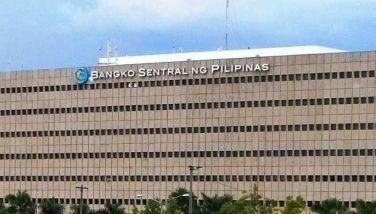SPAV law seen to trim banks’ NPLs to 8-9%
July 18, 2002 | 12:00am
Bangko Sentral ng Pilipinas (BSP) announced yesterday its target to bring down the banking sector’s non-performing loan (NPL) ratio to as low as eight to nine percent within 12 months of enacting the Special Purpose Asset Vehicle (SPAV) law.
Until the banking sector shows significant improvement, however, the BSP said it is not likely to heed the industry’s request for the central bank to remove the reserve requirements for common trust fund (CTF).
BSP Gov. Rafael Buenaventura told reporters yesterday that the banking sector’s NPL ratio could be brought down relatively fast from the present 18.43 percent average once the SPAV law has been passed and implemented.
According to Buenaventura, the banking industry is only waiting for the SPAV law to provide the way for them to reduce their NPL ratios to more manageable levels.
"We’d like to see the NPL ratio to go down to 8-9 percent," Buenaventura said, adding that once NPL ratios go down, lending should also begin improving since banks would be in a better position to start lending again.
"Lending should go up by a corresponding 10 percent," he said. Buenaventura said the BSP would also be more inclined to consider the proposal of the banking industry to remove the reserve requirement for common trust funds (CTF) now at seven percent.
The industry has been asking the BSP to remove the reserve requirement for CTF, saying that the Philippines is the only country in the world that subjects the CTF to a reserve requirement. At present, the Trust Officers Association of the Philippines said that the total CTF amounts to P111 billion and lifting the requirement would free at least P15.54 billion for lending.
According to Buenaventura, banks were not lending anyway and it had no need for more loanable funds.
"There is so much excess liquidity chasing after so few investment [options]," he said.
"If we do it, the money is going to end up in our vaults anyway." Once the banking industry’s fundamentals improve enough to resume lending, Buenaventura said the CTF reserve would be one of the first things to go.
"When there is enough economic activity, we can consider this. But right now, there isn’t enough lending going on anyway and we can easily see there is excess liquidity in the system," he said. – Des Ferriols
Until the banking sector shows significant improvement, however, the BSP said it is not likely to heed the industry’s request for the central bank to remove the reserve requirements for common trust fund (CTF).
BSP Gov. Rafael Buenaventura told reporters yesterday that the banking sector’s NPL ratio could be brought down relatively fast from the present 18.43 percent average once the SPAV law has been passed and implemented.
According to Buenaventura, the banking industry is only waiting for the SPAV law to provide the way for them to reduce their NPL ratios to more manageable levels.
"We’d like to see the NPL ratio to go down to 8-9 percent," Buenaventura said, adding that once NPL ratios go down, lending should also begin improving since banks would be in a better position to start lending again.
"Lending should go up by a corresponding 10 percent," he said. Buenaventura said the BSP would also be more inclined to consider the proposal of the banking industry to remove the reserve requirement for common trust funds (CTF) now at seven percent.
The industry has been asking the BSP to remove the reserve requirement for CTF, saying that the Philippines is the only country in the world that subjects the CTF to a reserve requirement. At present, the Trust Officers Association of the Philippines said that the total CTF amounts to P111 billion and lifting the requirement would free at least P15.54 billion for lending.
According to Buenaventura, banks were not lending anyway and it had no need for more loanable funds.
"There is so much excess liquidity chasing after so few investment [options]," he said.
"If we do it, the money is going to end up in our vaults anyway." Once the banking industry’s fundamentals improve enough to resume lending, Buenaventura said the CTF reserve would be one of the first things to go.
"When there is enough economic activity, we can consider this. But right now, there isn’t enough lending going on anyway and we can easily see there is excess liquidity in the system," he said. – Des Ferriols
BrandSpace Articles
<
>
- Latest
- Trending
Trending
Latest
Trending
Latest
Recommended




























